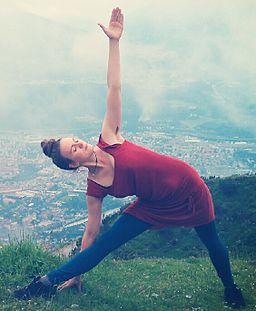As I think I’ve mentioned before, I sleep curled up on my side — usually with one or two small dogs filling my empty spaces. As part of my job, I spent a fair bit of time bending over a desk — either mine or, more often, the desk of one of my students. Even if mental or emotional stress never came into play, I cannot deny that I carry a lot of physical tension in my neck, shoulders, and upper back.
At class last week, another teacher (teacher in my building, regular student of the class) commented that she also carries a lot of her stress in her upper back. I get the impression that this is not an uncommon thing.
So I thought a class focusing on opening those areas might be appreciated.
This one is a fairly slow moving, moderately intense hatha practice. When I practice it, it has just enough standing and strength work that I don’t consider it a gentle practice — but enough subtle, seated work that I also don’t consider it vigorous overall. Your experience may vary, of course, depending on a whole lot of things.

Length: 45-50 minutes, savasana included.
Props: strap, possibly a block for triangle, possibly a cushion for seated work
Cautions: This is probably not a practice I would use if I had an acute neck or shoulder injury. I’d also be careful with it if I had any chronic neck or shoulder issues that acted up sometimes.
Slow & Steady Shoulder Practice
- Begin seated comfortably. Exhale chin to chest. Inhale chin toward ceiling, stopping where the neck still feels comfortable and safe. Repeat for 5 rounds. Return neck to neutral.
- Exhale left ear toward left shoulder. Inhale to center. Exhale right ear to right shoulder. Inhale to center. Repeat for 5 rounds.
- Exhale, turn head to the left, stopping where the stretch still feels comfortable and safe. Inhale to center. Exhale, turn head to the right. Inhale to center. Repeat for 5 rounds.
- Exhale chin to chest. Inhale, rotate left ear toward left shoulder. Exhale chin to chest. Inhale, rotate right ear toward right shoulder. Exhale chin to chest. Repeat for 5 rounds. Return neck to neutral.
- Inhale, interlace fingers at heart center. Exhale, press palms forward while rounding the spine. Inhale palms to ceiling. Exhale fingertips to floor behind hips. Inhale, lift heart center into a mild backbend. Exhale, release.
- Repeat the above sequence for a total of 5 rounds. Instead of touching the fingertips to the floor, consider the option of clasping hands behind back and inhaling to extend elbows straight during the backbend. As the person with tight shoulders, this option is not for everyone: I get it.
- Rise to hands and knees. Cat and cow, 5 rounds.
- Twisted child’s pose. First exhale into and inhale out of it for 5 breaths, then hold for 5 breaths. Repeat the sequence on the second side.
- Modified side plank, with full arm circles, 10 breaths on each side.
- Gate pose, 10 breaths on each side.
- Down dog, 10 breaths. (Note: I accidentally just mistyped this as “110 breaths.” Go for it if that is your thing. But that is not in the general spirit of this practice.)
- Dolphin, 10 breaths.
- Step forward to an uttanasana, ardha uttanasana vinyasa for 5 breaths.
- Eagle, 10 breaths on each side.
- Triangle, 10 breaths on each side.

- Step back to down dog, lower to kneeling, swing legs around to seated.
- Reverse table, 5 breaths vinyasa to 5 breath hold.
- Option to repeat vinyasa, hold, or to move to upward plank hold for 5 breaths.
- Seated gomukhasana arms with strap, 10 breaths per side.
- Seated twist, 10 breaths per side.
- Move to reclining, taking a few breaths to work out any kinks that might be going on. Consider some mild spinal twists during this time.
- Savasana. All the savasana.


